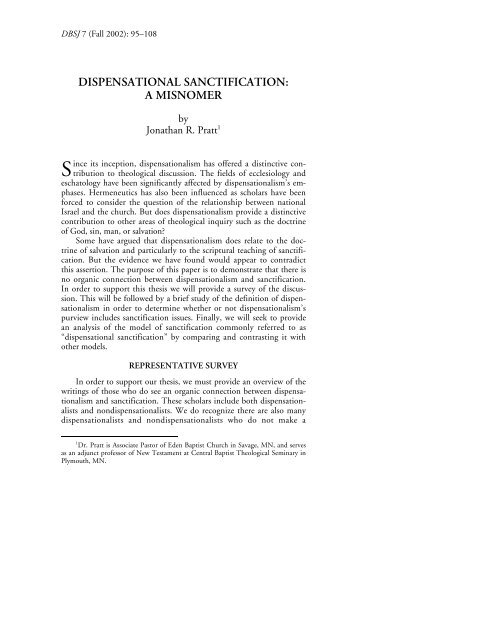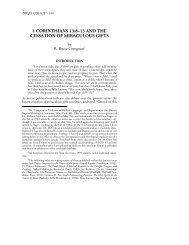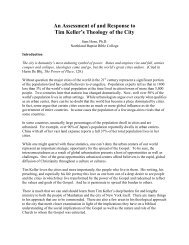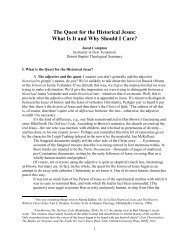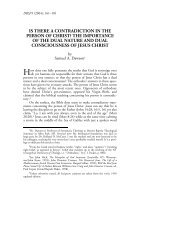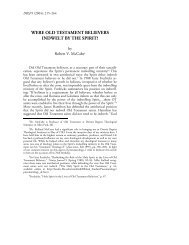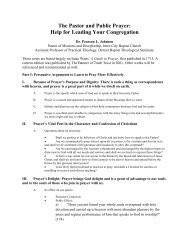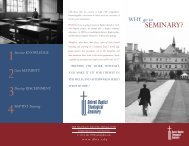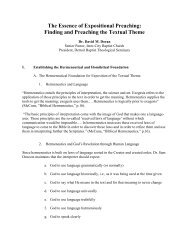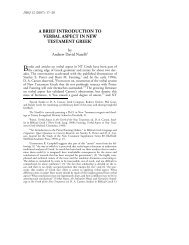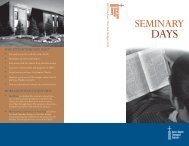Dispensational Sanctification: A Misnomer - Detroit Baptist ...
Dispensational Sanctification: A Misnomer - Detroit Baptist ...
Dispensational Sanctification: A Misnomer - Detroit Baptist ...
You also want an ePaper? Increase the reach of your titles
YUMPU automatically turns print PDFs into web optimized ePapers that Google loves.
DBSJ 7 (Fall 2002): 95–108<br />
DISPENSATIONAL SANCTIFICATION:<br />
A MISNOMER<br />
by<br />
Jonathan R. Pratt 1<br />
S<br />
ince its inception, dispensationalism has offered a distinctive contribution<br />
to theological discussion. The fields of ecclesiology and<br />
eschatology have been significantly affected by dispensationalism’s emphases.<br />
Hermeneutics has also been influenced as scholars have been<br />
forced to consider the question of the relationship between national<br />
Israel and the church. But does dispensationalism provide a distinctive<br />
contribution to other areas of theological inquiry such as the doctrine<br />
of God, sin, man, or salvation<br />
Some have argued that dispensationalism does relate to the doctrine<br />
of salvation and particularly to the scriptural teaching of sanctification.<br />
But the evidence we have found would appear to contradict<br />
this assertion. The purpose of this paper is to demonstrate that there is<br />
no organic connection between dispensationalism and sanctification.<br />
In order to support this thesis we will provide a survey of the discussion.<br />
This will be followed by a brief study of the definition of dispensationalism<br />
in order to determine whether or not dispensationalism’s<br />
purview includes sanctification issues. Finally, we will seek to provide<br />
an analysis of the model of sanctification commonly referred to as<br />
“dispensational sanctification” by comparing and contrasting it with<br />
other models.<br />
REPRESENTATIVE SURVEY<br />
In order to support our thesis, we must provide an overview of the<br />
writings of those who do see an organic connection between dispensationalism<br />
and sanctification. These scholars include both dispensationalists<br />
and nondispensationalists. We do recognize there are also many<br />
dispensationalists and nondispensationalists who do not make a<br />
1 Dr. Pratt is Associate Pastor of Eden <strong>Baptist</strong> Church in Savage, MN, and serves<br />
as an adjunct professor of New Testament at Central <strong>Baptist</strong> Theological Seminary in<br />
Plymouth, MN.
96 <strong>Detroit</strong> <strong>Baptist</strong> Seminary Journal<br />
connection between dispensationalism and sanctification. But our goal<br />
here is intentionally limited to those dispensationalists and nondispensationalists<br />
who have connected dispensationalism with a model of<br />
sanctification calling it “dispensational sanctification.” We will survey<br />
these scholars and then inquire whether or not they agree as to the<br />
particular model of sanctification they are identifying as “dispensational<br />
sanctification.”<br />
<strong>Dispensational</strong>ists<br />
John Walvoord clearly stands out as one of the most prominent<br />
dispensational scholars of the twentieth century. When asked to contribute<br />
to a book dealing with sanctification in Zondervan’s Counterpoint<br />
Series, Walvoord entitled his chapter, “The Augustinian-<br />
<strong>Dispensational</strong> Perspective.” 2 Walvoord never attempts to explain the<br />
connection between his view of sanctification and dispensationalism;<br />
he merely assumes it. He equates his “Augustinian-dispensational perspective”<br />
of sanctification with the teaching of Lewis Sperry Chafer. 3<br />
Another dispensationalist who uses the phrase “dispensational<br />
doctrine of sanctification,” is John Witmer. Like Walvoord he sees his<br />
viewpoint on the same plane as that espoused by Lewis Sperry Chafer. 4<br />
Nondispensationalists<br />
In his Primer on <strong>Dispensational</strong>ism 5 and in Wrongly Dividing the<br />
Word of Truth 6 John Gerstner provides strong criticism of the “dispensational<br />
theory of sanctification.” 7 He describes this theory by pointing<br />
to the sanctification teaching of two significant dispensationalists: John<br />
Nelson Darby and Lewis Sperry Chafer. One of Gerstner’s methodological<br />
errors in Wrongly Dividing the Word of Truth (his later and<br />
more comprehensive book) involves his failure to provide a definition<br />
and description of dispensationalism. Without this necessary starting<br />
2<br />
John F. Walvoord, “The Augustinian-<strong>Dispensational</strong> Perspective,” in Five Views<br />
on <strong>Sanctification</strong> (Grand Rapids: Zondervan, 1987), pp. 199–226.<br />
3 Ibid., pp. 223–24.<br />
4 John A. Witmer, “A Review of Wrongly Dividing the Word of Truth,” Bibliotheca<br />
Sacra 149 (April–June 1992): 144.<br />
5 John H. Gerstner, A Primer on <strong>Dispensational</strong>ism (Phillipsburg, NJ: Presbyterian<br />
and Reformed, 1982), pp. 10–15.<br />
6 John H. Gerstner, Wrongly Dividing the Word of Truth: A Critique of <strong>Dispensational</strong>ism<br />
(Brentwood, TN: Wolgemuth & Hyatt, Publishers, 1991), pp. 231–50.<br />
7 Ibid., p. 243.
<strong>Dispensational</strong> <strong>Sanctification</strong> 97<br />
point he tends to pick and choose significant (and not-so-significant) 8<br />
dispensationalists as representative of dispensationalism’s viewpoint<br />
regarding various aspects of theology. Because of this methodological<br />
error, Gerstner assumes a connection between dispensationalism and a<br />
particular model of sanctification, but he never demonstrates it. What<br />
is even more perplexing is that the two areas of theology most affected<br />
by dispensationalism (as will be seen below), eschatology and ecclesiology,<br />
are hardly touched upon at all.<br />
Curtis Crenshaw suggests that dispensationalists differ from the<br />
Reformed view of sanctification by making the Christian the “boss” in<br />
the sanctification process rather than God. 9 In this portion of his book<br />
Crenshaw is discussing the theological tendencies of dispensationalists<br />
and suggests that their view of sanctification (Chafer’s and Ryrie’s in<br />
this case) 10 either accompanies dispensationalism or is inherent to its<br />
system. 11 It is apparent in the development of his argument that Crenshaw<br />
believes that Ryrie and Chafer’s view of sanctification is inherent<br />
to dispensationalism. He traces this connection to dispensationalism’s<br />
rejection of the present rule of Christ by means of the law; this rejection<br />
then leads to the idea of rejecting the Lordship of Christ in salvation;<br />
this leads to the teaching of the “carnal Christian,” which is part<br />
of Ryrie and Chafer’s sanctification teaching. 12<br />
Summary<br />
Our survey has demonstrated that several dispensationalists and<br />
nondispensationalists have made the connection between dispensationalism<br />
and a particular model of sanctification. In every case we have<br />
seen the name of Lewis Sperry Chafer attached to this “dispensational<br />
sanctification.” In fact, Charles Ryrie has chosen to label his own view<br />
of sanctification as “Chaferian” 13 ; he does so in order to distinguish it<br />
8<br />
Richard L. Mayhue, “Who is Wrong A Review of John Gerstner’s Wrongly Dividing<br />
the Word of Truth” (The Master’s Seminary Journal 3 [Spring 1992]: 85), provides<br />
this helpful critique along with many others.<br />
9<br />
Curtis I. Crenshaw and Grover E. Gunn III, <strong>Dispensational</strong>ism Today, Yesterday,<br />
and Tomorrow (Memphis, TN: Footstool Publications, 1985), p. 100.<br />
10<br />
Ibid., pp. 94–101. Crenshaw refers particularly to the views demonstrated by<br />
Lewis Sperry Chafer, He That Is Spiritual, rev. ed. (Grand Rapids: Zondervan, 1967),<br />
and Charles C. Ryrie, “Contrasting Views on <strong>Sanctification</strong>,” in Walvoord: A Tribute,<br />
ed. Donald K. Campbell (Chicago: Moody Press, 1982), pp. 189–200.<br />
11 Ibid., p. 82.<br />
12 Ibid., pp. 83–84.<br />
13 Ryrie, “Contrasting Views,” p. 191.
98 <strong>Detroit</strong> <strong>Baptist</strong> Seminary Journal<br />
from the Keswick and Reformed models. 14<br />
Ryrie’s chosen title for his view of sanctification is significant not<br />
only because of what it says about its origin but also because of what it<br />
does not say about its connection. Ryrie does not label his view as<br />
“dispensational.” 15 Coming from one who has authored the book considered<br />
by many as the standard work on dispensationalism (<strong>Dispensational</strong>ism<br />
Today 16 ), this fact is quite important. For if someone who has<br />
worked so much on the essence and meaning of dispensationalism does<br />
not connect dispensationalism to his personal view of sanctification,<br />
further evaluation of this issue is necessary. This leads us to discuss the<br />
issue of definition to see whether or not the connection made by Walvoord,<br />
Witmer, Gerstner and Crenshaw can be sustained.<br />
DISPENSATIONALISM DEFINED<br />
Definition<br />
As with any theological system, dispensationalism has experienced<br />
“systematization and development” 17 during its relatively short history.<br />
For this reason we will primarily concentrate on more recent efforts<br />
made in the area of definition.<br />
Lewis Sperry Chafer summarizes dispensationalism in this way:<br />
“Throughout the ages God is pursuing two distinct purposes: one related<br />
to the earth with earthly people and earthly objectives involved,<br />
which is Judaism; while the other is related to heaven with heavenly<br />
people and heavenly objectives involved, which is Christianity.” 18<br />
14 We will provide more information on each of the sanctification models below.<br />
15<br />
At this point we should say that the majority of authors who have supported or<br />
criticized dispensationalism through the years mirror Ryrie’s perspective. We did find<br />
some significant scholars, particularly Walvoord and Gerstner, who link dispensationalism<br />
with a particular model of sanctification. But the majority of authors consulted<br />
for the present paper mention no connection at all. One will notice that Ryrie’s discussion<br />
of sanctification appears in an article about that subject (“Contrasting Views”)<br />
rather than in the books he has written about dispensationalism (see note 10).<br />
16<br />
Charles C. Ryrie, <strong>Dispensational</strong>ism Today (Chicago: Moody Press, 1966). We<br />
should also mention Ryrie’s later work: <strong>Dispensational</strong>ism, revised and expanded ed.<br />
(Chicago: Moody Press, 1995).<br />
17<br />
Ryrie, <strong>Dispensational</strong>ism Today, p. 9. This fact is widely acknowledged by nearly<br />
every student of dispensationalism. See Robert Saucy, “The Crucial Issue Between<br />
<strong>Dispensational</strong> and Non-<strong>Dispensational</strong> Systems,” Criswell Theological Review 1 (Fall<br />
1986): 149, and Craig A. Blaising, “Developing <strong>Dispensational</strong>ism Part 2 (of 2 parts):<br />
Development of <strong>Dispensational</strong>ism by Contemporary <strong>Dispensational</strong>ists,” Bibliotheca<br />
Sacra 145 (July–September 1988): 254–55.<br />
18 Lewis Sperry Chafer, <strong>Dispensational</strong>ism (Dallas: Dallas Seminary Press, 1936),<br />
p. 107.
<strong>Dispensational</strong> <strong>Sanctification</strong> 99<br />
Charles Ryrie boils down dispensationalism into three essential<br />
distinctives that he calls the sine qua non: 1) a distinction between national<br />
Israel and the church; 2) a hermeneutical method of literal interpretation;<br />
and 3) a doxological purpose of God in His dealings with<br />
man. 19<br />
John MacArthur, Jr. defines dispensationalism as “a system of biblical<br />
interpretation that sees a distinction between God’s program for<br />
Israel and His dealings with the church.” 20 He goes on to say that the<br />
central issue in dispensationalism is eschatology; he also suggests that<br />
dispensationalism has many implications for ecclesiology. 21<br />
Craig Blaising and Darrell Bock describe dispensationalism as a<br />
“futurist premillennialism that has strongly maintained the imminent<br />
return of Christ and a national and political future for Israel.” 22 Also, it<br />
is characterized by a “canonical approach to Scripture that interprets<br />
discontinuities of the Old and New Testaments as historical changes in<br />
divine-human dispensations reflecting different purposes in the divine<br />
plan.” This last point results in an emphasis on unique features in<br />
grace that belong to the present dispensation of the church. 23<br />
Robert Saucy states, “Anyone who asserts not only the restoration<br />
of Israel as a national entity but also a future role for that nation in<br />
God’s kingdom program has been generally identified as a dispensationalist.”<br />
24<br />
This succinct statement from Herb Bateman provides his assessment<br />
of the essence of dispensationalism: “Simply put, the basic unifying<br />
issue for all dispensationalists is that Israel is not the church.” 25<br />
Finally, John Feinberg presents six “core” items that are distinctive<br />
to dispensationalism: 1) the recognition of multiple senses for terms<br />
19<br />
Ryrie, <strong>Dispensational</strong>ism Today, pp. 44–47.<br />
20 John MacArthur, Jr., Faith Works: The Gospel According to the Apostles (Dallas:<br />
Word Publishing, 1993), p. 219.<br />
21 Ibid., p. 222.<br />
22<br />
Craig A. Blaising and Darrell L. Bock, “<strong>Dispensational</strong>ism, Israel and the<br />
Church: Assessment and Dialogue,” in <strong>Dispensational</strong>ism, Israel and the Church: The<br />
Search for Definition, ed. Craig A. Blaising and Darrell L. Bock (Grand Rapids: Zondervan,<br />
1992), p. 379.<br />
23 Ibid.<br />
24<br />
Robert L. Saucy, The Case for Progressive <strong>Dispensational</strong>ism: The Interface Between<br />
<strong>Dispensational</strong> and Non-<strong>Dispensational</strong> Theology (Grand Rapids: Zondervan,<br />
1993), p. 9.<br />
25 Herbert W. Bateman IV, “<strong>Dispensational</strong>ism Tomorrow,” in Three Central Issues<br />
in Contemporary <strong>Dispensational</strong>ism: A Comparison of Traditional and Progressive<br />
Views, ed. Herbert W. Bateman IV (Grand Rapids: Kregel, 1999), p. 308.
100 <strong>Detroit</strong> <strong>Baptist</strong> Seminary Journal<br />
like “Jew” and “Seed of Abraham”; 2) a hermeneutical practice which<br />
seeks to properly understand the progress of revelation, typology, and<br />
the NT reinterpretation of the OT; 3) the necessity of double fulfillment<br />
for covenant promises made to Israel; 4) a distinctive future for<br />
ethnic Israel; 5) the belief in the church as a distinctive organism; and<br />
6) a stress on the multi-faceted aspects of God’s workings in history. 26<br />
We have sought to provide a diverse and representative snapshot<br />
of definitional attempts made by some significant dispensational scholars.<br />
An early Dallas Seminary dispensationalist (Chafer) and four later<br />
Dallas-trained professors (Ryrie, Blaising, Saucy and Bock) have been<br />
consulted. Also, two Talbot Seminary grads (MacArthur and Feinberg)<br />
have contributed to our survey. Philadelphia College of the Bible is<br />
also represented (Bateman, who is also a Dallas Seminary Ph.D. grad).<br />
Not counting Chafer (deceased) and Ryrie (retired), this group represents<br />
a number of different schools in their present teaching ministries:<br />
Bock (Dallas Seminary), Blaising (Southwestern <strong>Baptist</strong> Seminary),<br />
MacArthur (Masters Seminary), Feinberg (Trinity Evangelical Divinity<br />
School), Bateman (Grace Seminary), and Saucy (Talbot Seminary).<br />
Summary<br />
In observing these various definitional attempts, we are struck by<br />
their similarity and agreement, particularly with regard to the distinction<br />
between Israel and the church. Charles Ryrie’s statement could<br />
have been made after perusing our list: “This [the distinction between<br />
Israel and the church] is probably the most basic theological test of<br />
whether or not a person is a dispensationalist, and it is undoubtedly<br />
the most practical and conclusive.” 27<br />
Another concluding observation is in order as well. None of these<br />
definitions comes close to providing a connection between dispensationalism<br />
and sanctification. As MacArthur has suggested (see p. 4),<br />
dispensationalism certainly does have significant ramifications for eschatology<br />
and ecclesiology, but such doctrines as soteriology, anthropology,<br />
and theology proper are not affected. Neither Chafer 28 nor<br />
26<br />
John Feinberg, “Systems of Discontinuity,” in Continuity and Discontinuity<br />
Perspectives on the Relationship Between the Old and New Testaments: Essays in Honor of<br />
S. Lewis Johnson, Jr., ed. John Feinberg (Westchester, IL: Crossway, 1988), pp. 71–85.<br />
27 Ryrie, <strong>Dispensational</strong>ism, p. 39.<br />
28 Chafer, He that Is Spiritual; idem, Major Bible Themes, rev. John F. Walvoord<br />
(Grand Rapids: Zondervan, 1974); and idem, Systematic Theology, vol. 7 (Dallas: Dallas<br />
Seminary Press, 1948), pp. 279–84. Chafer never mentions dispensationalism in<br />
his discussions of sanctification in any of these writings.
<strong>Dispensational</strong> <strong>Sanctification</strong> 101<br />
Ryrie, 29 both of whom have written extensively on the doctrine of<br />
sanctification and both of whose views on sanctification have been tied<br />
to dispensationalism (see pp. 1–2), ever makes the connection between<br />
sanctification and dispensationalism. 30<br />
Thus, after investigating the definition of dispensationalism, we<br />
can find no organic connection between sanctification and dispensationalism.<br />
31 But how are we to understand the model of sanctification<br />
espoused by Chafer, Ryrie, Walvoord and others If it is not to be defined<br />
by its tie to dispensationalism, then how is it to be explained<br />
This leads us to discuss the various models of sanctification in order to<br />
correctly identify this so-called “dispensational sanctification.”<br />
29 Charles Caldwell Ryrie, Balancing the Christian Life (Chicago: Moody Press,<br />
1969), pp. 61–83; idem, “Contrasting Views,” p. 191. As mentioned above on p. 3,<br />
Ryrie prefers to label his view of sanctification as Chaferian rather than dispensational.<br />
30<br />
B. B. Warfield never mentions Chafer’s dispensationalism in his review of<br />
Chafer’s He that Is Spiritual (Princeton Theological Review 17 (April 1919): 322–27).<br />
In light of the fact that Warfield has no problem giving labels to Chafer’s view of<br />
sanctification (such as “Higher Life,” “Arminian,” and “quietistic”), we would expect<br />
him to make a connection between Chafer’s sanctification and his dispensationalism,<br />
but Warfield never does.<br />
31 One might well ask at this point how the Chaferian model of sanctification (to<br />
use Ryrie’s term) ever came to be tied to dispensationalism. There are at least three<br />
suggested proposals, and we will add a fourth. 1) <strong>Dispensational</strong>ism’s tendency to<br />
compartmentalize truth led to this type of sanctification teaching (John F. MacArthur,<br />
Jr., The Gospel According to Jesus [Grand Rapids: Zondervan, 1988], pp. 24–25). 2)<br />
<strong>Dispensational</strong>ism’s emphasis on God’s electing purpose for national Israel suggests<br />
that, regardless of Israel’s sin problems through the centuries, God remains faithful to<br />
His covenant promises to her. This same emphasis is applied to the individual believer<br />
in this present age. The believer is absolutely secure in his relationship with God even<br />
though he or she may fall far away from Him. Thus, the emphasis on carnal as opposed<br />
to spiritual believers occurs (C. Norman Kraus, <strong>Dispensational</strong>ism in America: Its<br />
Rise and Development [Richmond, VA: John Knox, 1958], pp. 61–62). 3) The dispensational<br />
emphasis on pure grace as opposed to the bondage of the Mosaic Law leads to<br />
a rejection of the necessity of the lordship of Christ in the salvation message. This<br />
permits the possibility and expectancy of carnal Christians who have failed to accept<br />
Christ’s lordship in their justified state (MacArthur, Faith Works, pp. 228–29, and<br />
Crenshaw, pp. 82–84). 4) <strong>Dispensational</strong>ism’s expectation of the apostate nature of<br />
Christendom at the end of the present age of grace points to an expectation of disobedience<br />
on the part of true Christians. Hence, a group of carnal Christians is foreseen<br />
by this proposal; if the church were able to avoid carnality, apostasy would not arise.<br />
But one would expect an apostate generation to arise if a group of carnal Christians<br />
failed to train them as they should have.<br />
All of these suggestions are possibilities, but none of them could be considered<br />
theologically necessary. Belief in compartmentalization, the election of national Israel,<br />
emphasis on pure grace as opposed to law, and the apostate nature of Christendom<br />
does not require one to adopt any particular view of sanctification.
102 <strong>Detroit</strong> <strong>Baptist</strong> Seminary Journal<br />
MODELS OF SANCTIFICATION<br />
We will consider five models of sanctification in this portion of<br />
the paper. 32 Rather than delineating the historical background and specific<br />
doctrinal details of each one, we will seek to broadly summarize<br />
the main emphases of each model and then provide some comparisons<br />
and contrasts between them. In particular our discussion of each<br />
model will center upon the significance of a post-conversion sanctification<br />
experience and the relationship between justification and sanctification.<br />
Wesleyan <strong>Sanctification</strong><br />
John Wesley’s main contribution to sanctification teaching is his<br />
separation of justification from sanctification, both of which are to be<br />
received in separate acts of faith. Wesley describes this sanctification as<br />
“entire sanctification” or “perfection.” 33 The experience of receiving<br />
this type of sanctification has five specific elements: 1) it is instantaneous;<br />
34 2) it is distinctly subsequent to justification; 35 3) it is only received<br />
by those who seek for it; 36 4) it defines sin as “conscious,<br />
deliberate acts”; 37 and 5) it may be lost. 38<br />
Thus, Wesleyan sanctification emphasizes the necessity of a postconversion<br />
experience of entire sanctification that is attained by an act<br />
of faith distinct from justification. In this model the relationship between<br />
justification and sanctification 39 is merely a possibility.<br />
32 These are the same five models presented in Five Views on <strong>Sanctification</strong> (Grand<br />
Rapids: Zondervan, 1987).<br />
33 John Wesley, “Scripture Way of Salvation,” in Sermons on Several Occasions, ed.<br />
T. Jackson, vol. 1 (New York: G. Lane and C. B. Tippett, 1845), pp. 386, 390.<br />
34 John Wesley, A Plain Account of Christian Perfection (Chicago: The Christian<br />
Witness Co., n.d.), pp. 25, 52, 104.<br />
35 Ibid., p. 46.<br />
36<br />
Ibid., p. 35.<br />
37 Ibid., pp. 26–28.<br />
38<br />
Ibid., p. 104.<br />
39 When using the term “sanctification” with justification in this discussion, we<br />
are specifically speaking of experiential or progressive sanctification. Most writers admit<br />
to some type of positional sanctification that occurs at the point of conversion, but<br />
our discussion here is centered upon the understanding of the relationship between<br />
justification and progressive sanctification.
<strong>Dispensational</strong> <strong>Sanctification</strong> 103<br />
Pentecostal <strong>Sanctification</strong><br />
Flowing out of the Wesleyan holiness movement of the nineteenth<br />
century, Pentecostal sanctification maintains that a post-conversion<br />
experience sought by the believer is a necessity. 40 Rather than seeking<br />
for entire sanctification, Pentecostals seek for baptism in the Spirit. 41<br />
The result of this Spirit baptism is empowerment for service (rather<br />
than the Wesleyan concept of perfection in love). 42 Stanley Horton<br />
summarizes Pentecostal sanctification teaching by explaining that baptism<br />
in the Spirit is an event subsequent to and distinct from justification;<br />
it empowers the individual for various types of Christian service;<br />
and it is a blessing that should be sought by all believers. 43<br />
Again, we see the necessity for a post-conversion experience. We<br />
also note that the link between justification and sanctification is only a<br />
possibility based upon a believer’s decision to seek baptism in the<br />
Spirit.<br />
Keswick <strong>Sanctification</strong><br />
Like Pentecostal sanctification Keswick theology shares many<br />
similarities with the Wesleyan holiness movement. 44 One example of<br />
this similarity is that it views sanctification and justification as two<br />
40<br />
Charles Edwin Jones, Perfectionist Persuasion: The Holiness Movement and<br />
American Methodism, 1867–1936, ATLA Monograph Series, vol. 5 (Metuchen, NJ:<br />
Scarecrow Press, 1974), pp. 4–5.<br />
41 Timothy L. Smith, “The Doctrine of the Sanctifying Spirit: Charles G. Finney’s<br />
Synthesis of Wesleyan and Covenant Theology,” Wesleyan Theological Journal 13<br />
(Spring 1978): 100–103, and Frederick Dale Bruner, A Theology of the Holy Spirit: The<br />
Pentecostal Experience and the New Testament Witness (Grand Rapids: Eerdmans,<br />
1970), p. 38.<br />
42<br />
Stanley M. Horton, “The Pentecostal Perspective,” in Five Views of <strong>Sanctification</strong><br />
(Grand Rapids: Zondervan, 1987), p. 130. Although he was not a Pentecostal, R.<br />
A. Torrey (The Baptism with the Holy Spirit, 6 th ed. [London: James Nisbet & Co.,<br />
1905], p. 13) also argued for this meaning of Spirit baptism. This was a common<br />
theme among most American revivalists at the turn of the century. Also see Douglas<br />
Robinson, “The ‘Ordo Salutis’ and Charismatic Movement,” Churchman 97 (1983):<br />
p. 233.<br />
43<br />
Horton, “The Pentecostal Perspective,” pp. 128–34. Howard M. Ervin (Conversion-Initiation<br />
and the Baptism in the Holy Spirit. A Critique of James D. G. Dunn’s<br />
Baptism in the Holy Spirit [Peabody, MA: Hendrickson, 1984], p. vii) confirms the<br />
first two of these points.<br />
44 W. Ralph Thompson, “An Appraisal of the Keswick and Wesleyan Contemporary<br />
Positions,” Wesleyan Theological Journal 1 (Spring 1966): pp. 11–20; and Everett<br />
L. Cattell, “An Appraisal of the Keswick and Wesleyan Contemporary Positions,” in<br />
Insights into Holiness, ed. Kenneth Geiger (Kansas City, MO: Beacon Hill Press,<br />
1962), pp. 264–65.
104 <strong>Detroit</strong> <strong>Baptist</strong> Seminary Journal<br />
distinct gifts from God to be received in separate acts of faith. Believers<br />
receive the gift of sanctification through a “crisis” decision. 45 Before<br />
this “crisis” decision takes place, believers find themselves in the position<br />
of the “carnal Christian.” After this decision they enjoy the “victorious<br />
life” in which the believers’ spiritual nature is able to counteract<br />
the sinful nature so that they can live on the plane of victory and receive<br />
the “fullness of the Spirit.” 46 Thus, the result of this postconversion<br />
experience of “crisis” is that believers can enjoy “consistent<br />
success in resisting temptation to violate deliberately the known will of<br />
God.” 47<br />
Keswick shares similarities with both the Wesleyan and Pentecostal<br />
models in its emphasis on a post-conversion experience as a necessity<br />
for “victorious” living. The obedience one would expect to see in<br />
the life of the sanctified believer is only a possibility based upon the<br />
individual believer’s willingness to make his crucial post-conversion<br />
decision.<br />
Chaferian (“<strong>Dispensational</strong>”) <strong>Sanctification</strong><br />
We have chosen to use Charles Ryrie’s suggested title for this<br />
model of sanctification, 48 and we have already stated above that this is<br />
the model often referred to as “dispensational” sanctification. Some<br />
have referred to this viewpoint as the “Dallas view” 49 since the vast<br />
majority of its adherents are graduates of Dallas Theological Seminary<br />
and follow its founder’s perspective on sanctification. 50<br />
45 Steven Barabas, So Great Salvation (Westwood, NJ: Fleming H. Revell, 1952),<br />
pp. 84–86, 115; and J. Robertson McQuilkin, “The Keswick Perspective,” in Five<br />
Views on <strong>Sanctification</strong> (Grand Rapids: Zondervan, 1987), p. 178.<br />
46<br />
W. H. Griffith Thomas, “The Victorious Life [II.],” Bibliotheca Sacra 76 (October<br />
1919): 464; McQuilkin, “The Keswick Perspective,” pp. 153, 175–78.<br />
47<br />
McQuilkin, “The Keswick Perspective,” p. 155.<br />
48 Ryrie, “Contrasting Views,” p. 191.<br />
49<br />
See William W. Combs, “The Disjunction Between Justification and <strong>Sanctification</strong><br />
in Contemporary Evangelical Theology,” <strong>Detroit</strong> <strong>Baptist</strong> Seminary Journal 6<br />
(Fall 2001): 28–33, whose section entitled “The Dallas Seminary Theology” provides a<br />
helpful history and description of Chaferian sanctification.<br />
50 Chafer, He that Is Spiritual. A representative list of Dallas Seminary alumni who<br />
have written on this subject is necessary here: Walvoord, “Augustinian-<strong>Dispensational</strong><br />
Perspective,” and idem, The Holy Spirit, 3d ed. (Grand Rapids: Zondervan, 1958);<br />
Charles C. Ryrie, Balancing the Christian Life; J. Dwight Pentecost, Designed to Be Like<br />
Him: Fellowship, Conduct, Conflict, Maturity (Chicago: Moody Press, 1966); Zane<br />
Hodges, Absolutely Free! A Biblical Reply to Lordship Salvation (Grand Rapids: Zondervan,<br />
1989); Robert Wilkin, “<strong>Sanctification</strong> Part 4: Man’s Role in Present <strong>Sanctification</strong><br />
(with an Appendix Containing Questions and Answers),” Journal of the Grace
<strong>Dispensational</strong> <strong>Sanctification</strong> 105<br />
Maintaining the Keswick perspective on the two natures within<br />
the Christian, Chaferians teach that victory over the sinful nature is<br />
accomplished by yieldedness to the Spirit in an act of dedication or<br />
surrender. 51 As with the preceding models, Chaferians separate sanctification<br />
and justification. They propose that an act of dedication on<br />
the part of the believer is necessary in order to initiate the process of<br />
sanctification.<br />
Reformed <strong>Sanctification</strong><br />
Reformed theology emphasizes the inevitable occurrence of obedience<br />
(sanctification) in the life of the justified. 52 God is seen as the<br />
primary impetus behind the believers’ growth in obedience as He<br />
prompts them to obey. 53 Believers, in turn, are responsible to obey the<br />
commands of God, but they will do so because of the sanctifying work<br />
of God in the believer’s heart. 54<br />
Before proceeding to the concluding paragraph under this model<br />
of sanctification, we would like to take note of several dispensationalists<br />
who are advocates of the reformed model. 55 These include early<br />
Evangelical Society 7 (Autumn 1994): 3–23; and Joseph C. Dillow, The Reign of the<br />
Servant Kings: A Study of Eternal Security and the Final Significance of Man (Haysville,<br />
NS: Schoettle Publishing Co., 1992). See Combs, “The Disjunction Between Justification<br />
and <strong>Sanctification</strong> in Contemporary Evangelical Theology,” pp. 31–32, for a<br />
more comprehensive listing.<br />
51 Chafer, He that Is Spiritual, p. 22; Ryrie, Balancing, pp. 186–91; Pentecost, Designed<br />
to Be Like Him, pp. 127–30.<br />
52<br />
This is basically the doctrine of perseverance, and it is affirmed by many theologians<br />
including John Calvin, Institutes of the Christian Religion, 3.3.1; A. A. Hodge,<br />
Outlines of Theology, rev. ed. (n.p.: Robert Carter and Brothers, 1878; reprint, Grand<br />
Rapids: Eerdmans, 1928), p. 522; and B. B. Warfield, Perfectionism, ed. Samuel G.<br />
Craig (Grand Rapids: Baker, 1958), p. 356.<br />
53<br />
Charles Hodge, Systematic Theology, vol. 3 (reprint, Grand Rapids: Eerdmans,<br />
1981–89), pp. 215–16, points to 1 Thess 5:23; Heb 13:20,21 and Titus 2:14 as evidence<br />
of this point. Also see Cary N. Weisiger III, “The Reformed Doctrine of <strong>Sanctification</strong>,”<br />
Christianity Today (1 September 1967): Supplement, p. 23.<br />
54 Warfield (review of He that Is Spiritual, p. 327) writes: “He who believes in Jesus<br />
Christ is under grace, and his whole course, in its process and its issue alike, is<br />
determined by grace, and therefore, having been predestined to be conformed to the<br />
image of God’s Son, he is surely being conformed to that image…. You may find<br />
Christians at every stage of this process, for it is a process through which all must pass;<br />
but you will find none who will not in God’s own good time and way pass through<br />
every stage of it.”<br />
55 Though we could also have mentioned dispensationalists who hold to the<br />
Keswick and Pentecostal views when we discussed those models, we have chosen to<br />
insert this list under the Reformed heading since most attacks against “dispensational
106 <strong>Detroit</strong> <strong>Baptist</strong> Seminary Journal<br />
dispensationalists like H. A. Ironside who writes, “Nowhere in Scripture<br />
is it taught that there is a sudden leap to be taken from carnality<br />
to spiritualty, or from a life of comparative unconcern as to godliness<br />
to one of intense devotion to Christ.” 56 To this group we can add Alva<br />
J. McClain, 57 Homer Kent, 58 Robert Saucy, 59 John MacArthur, Jr., 60<br />
David Turner, 61 J. Lanier Burns, 62 and Robert A. Pyne. 63 (These last<br />
two dispensationalists are currently professors at Dallas Seminary).<br />
In distinction to the previous four views, the Reformed position<br />
neither expects nor encourages a post-conversion decision prior to<br />
sanctification. God works in believers’ hearts causing them to live obediently.<br />
Christians participate in this process but only as the indwelling<br />
ministry of the Spirit gives direction. Thus, sanctification is seen as an<br />
inevitable or necessary result of justification.<br />
sanctification” have come from the Reformed camp. Contrary to the understanding of<br />
some in Reformed theology (particularly covenantalists), it is possible to hold to the<br />
Reformed view of soteriology while still remaining a dispensationalist. See Stephen R.<br />
Spencer, “Reformed Theology, Covenant Theology, and <strong>Dispensational</strong>ism,” in Integrity<br />
of Heart, Skillfulness of Hands: Biblical and Leadership Studies in Honor of Donald<br />
K. Campbell, ed. Charles H. Dyer and Roy B. Zuck (Grand Rapids: Baker, 1994), pp.<br />
238–54, who shows that “Reformed theology is larger than covenant theology and that<br />
a person may align with Reformed theology without aligning with covenant theology”<br />
(p. 239).<br />
56 H. A. Ironside, Holiness: The False and the True (New York: Loizeaux Brothers,<br />
n.d.), pp. 139–40. Also pp. 41–42, 49, 56, 132; idem, The Eternal Security of the Believer<br />
(New York: Loizeaux Brothers, 1934), pp. 12–13.<br />
57 Alva J. McClain, Romans: The Gospel of God’s Grace, ed. Herman A. Hoyt (Chicago:<br />
Moody Press, 1973), p. 166.<br />
58 Homer Kent, review of The Gospel According to Jesus , by John F. MacArthur,<br />
Jr., in Grace Theological Journal 10 (Spring 1989): pp. 67–77.<br />
59 Robert L. Saucy, “Second Response to ‘Faith According to the Apostle James’<br />
by John F. MacArthur, Jr.,” Journal of the Evangelical Theological Society 33 (March<br />
1990): pp. 43–47.<br />
60 MacArthur, Faith Works, 219–29; idem, The Gospel According to Jesus.<br />
61<br />
David L. Turner, review of Five Views on <strong>Sanctification</strong>, by Melvin E. Dieter,<br />
Anthony A. Hoekema, Stanley M. Horton, J. Robertson McQuilkin, and John F.<br />
Walvoord, in Grace Theological Journal 10 (Spring 1989): 94–98.<br />
62 J. Lanier Burns, review of Paul and Perseverance: Staying in and Falling Away, by<br />
Judith M. Gundry Volf, in Bibliotheca Sacra 150 (January–March 1993): p. 123.<br />
63 Robert A. Pyne, review of Faith Works: The Gospel According to the Apostles, by<br />
John F. MacArthur, Jr., in Bibliotheca Sacra 150 (October–December 1993): pp.<br />
497–99.
<strong>Dispensational</strong> <strong>Sanctification</strong> 107<br />
Summary<br />
Though we did not take the time to consider the Wesleyan and<br />
Pentecostal views of justification, we must note that these models do<br />
propose a strongly Arminian approach to salvation. In such a theological<br />
scheme, God’s election is based upon an individual’s decision to be<br />
saved. This approach is also tied to their understanding of sanctification<br />
which is likewise based upon the believer’s decision to grow. Reformed,<br />
Keswick, and Chaferian scholars would all disagree with the<br />
Arminian approach to justification. However, both the Keswick and<br />
Chaferian schools would agree that the believer’s post-conversion dedication<br />
or crisis is necessary before sanctification begins. 64 The Reformed<br />
model, on the other hand, would suggest that God initiates<br />
both justification and sanctification in those whom He elects.<br />
The Wesleyan, Pentecostal, Keswick, and Chaferian models all<br />
agree that some form of a post-conversion decision is necessary before<br />
“real” or “victorious” growth can occur. While all acknowledge the<br />
work of God in sanctification, all appear to place a great responsibility<br />
upon believers themselves to initiate the growth process. On the other<br />
hand, the Reformed model proposes that believers will grow inevitably<br />
because of their conversion to Christ. Believers are responsible to obey<br />
and will do so because of the Spirit’s work in their lives. 65<br />
Finally, the relationship between justification and sanctification is<br />
viewed as inevitable and necessary in the Reformed model while in the<br />
Wesleyan, Pentecostal, Keswick and Chaferian models this relationship<br />
is understood as merely possible or potential. 66<br />
CONCLUSION<br />
Our study has shown that there are several scholars who have<br />
equated the Chaferian model of sanctification with dispensationalism.<br />
64<br />
Walvoord, “Augustinian-<strong>Dispensational</strong> Perspective,” p. 235, writes, “One’s<br />
experience of sanctification is clearly conditioned on one’s response to the sanctification<br />
that the Holy Spirit intends to provide…. Though sanctification is a work of God<br />
in the heart of the individual, it is accomplished only in harmony with the human<br />
response.”<br />
65<br />
Turner (review of Five Views, pp. 94–98) makes this same point several times by<br />
suggesting that the four views are contrasted with Reformed teaching in regard to the<br />
necessity of post-conversion experiences. He writes (p. 98): “Thus, there may only be<br />
two views of sanctification presented in this volume.”<br />
66<br />
For a more thorough treatment of this entire discussion see Combs, “The Disjunction<br />
Between Justification and <strong>Sanctification</strong> in Contemporary Evangelical Theology,”<br />
pp. 19–33; and Jonathan R. Pratt, “The Relationship between Justification and<br />
<strong>Sanctification</strong> in Romans 5–8,” (Ph.D. diss., Dallas Theological Seminary, 1999), pp.<br />
9–39.
108 <strong>Detroit</strong> <strong>Baptist</strong> Seminary Journal<br />
In studying the numerous definitions of dispensationalism we found<br />
that the main essence of dispensationalism is a distinction between<br />
national Israel and the church. Based on this finding we can conclude<br />
that there is certainly an organic connection between dispensationalism<br />
and eschatology and ecclesiology. But we found no evidence of any<br />
essential connection between dispensationalism and sanctification. Finally,<br />
we compared Chaferian (“dispensational”) sanctification with<br />
other models of sanctification. We found compatibility between<br />
Chaferian teaching and that of Wesleyan, Pentecostal, and Keswick<br />
approaches, particularly in regard to the necessity of a post-conversion<br />
experience and in regard to a separation between justification and<br />
sanctification.<br />
We trust that this study will encourage students of sanctification<br />
to avoid labeling any model as “dispensational.” We also hope that<br />
those who may have been inclined toward Chaferian sanctification<br />
because they thought it to be tied to dispensationalism will revisit this<br />
subject with the goal of basing their sanctification views on the text of<br />
Scripture rather than upon respect for a favorite theologian or theological<br />
system.


